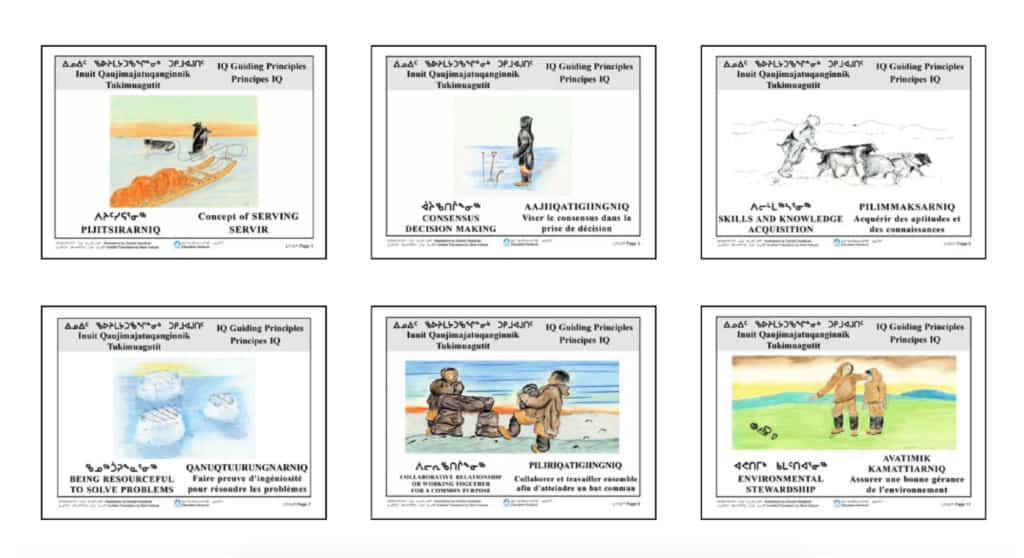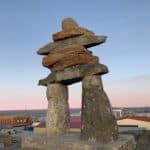Section Navigation
Message to Educators
This module provides you and your students with opportunities to explore Inuit values and cultural beliefs. We hope it will also allow you to explore the diverse value and belief systems your students bring into the classroom. Inuit say that the purpose in life is to live a good life. The information in this module will help you begin to make meaning of Inuit expectations for living a good life, especially in a changing environment where we face new challenges on many fronts.
Inuit Elders say that although the context we live in is always dynamic, our beliefs never need to change, and this is why it is so important to clarify values for youth. Inuit also say their teachings are helpful to anyone, and are not just for Inuit. With this in mind, we hope you will explore these Inuit understandings of how to live well in a dynamic world and that, in doing so, they will help you and your students set personal goals as agents of change in effectively meeting life’s challenges in order to live a good life.
– Shirley Tagalik
Introduction
Avattimik Kamatsiarniq • Respectful Stewardship
Topic: Setting expectations for becoming respectful stewards
It is important to recognize that the Inuit worldview is highly holistic. As such, its topics resist organization according to curricular subject divisions. The units presented here are cross-curricular in nature and aim to provide an understanding of Inuit Qaujimajatuqangit (worldview—IQ) and how Inuit beliefs and perspectives set the stage for respectful stewardship of all life and the guiding principle of avattimik kamatsiarniq. A short PowerPoint document is provided as background (access the PowerPoint in the Resource Kit).
Students will learn that the values we hold help to determine the way we live our lives. Therefore, it is important to examine our understanding of our values, as well as the beliefs that underpin them. Our values are usually set and reinforced by the teachings of our parents. To Inuit this is known as inutsiaqpagutit. These teachings provide lifelong expectations for our behaviour.
Learning Goals
Students will understand that a value is a belief. They will begin to examine the values that are most important to them, and to understand how holding these values has an impact on their behaviour. Values, therefore, are critical to building personal character.
Vocabulary
- Inutsiaqpagutit – That which enables you to have a good life
Guiding Questions
- What do I believe?
- How do I behave according to my beliefs?
Curriculum Links
This is an interdisciplinary unit of study suitable for a thematic approach to learning about values, the self, social expectations and interactions, and the impact our values have on who we become and what we choose to do in life.
Materials
- Outline of a child PDF (access this PDF in the Resource Kit)
- Inutsiaqpagutit statement (access this PDF in the Resource Kit)
- IQ Principles large-size posters (access this PDF in the Resource Kit)
- Printable Inuit Values booklet and value cards (access this PDF in the Resource Kit)
- Game board spinner, empty bottle or something similar
Activities
Activity 1: Introduction
Provide each student with the outline of a child PDF and have them use it to create a self-portrait. As much as possible, students should include accurate details. While they are working, circulate and ask each child to provide some words that describe what they would like to be known for. Write these words around the drawing. Encourage students to find words that indicate positive characteristics such as kind, helpful, a good friend, etc.
Have the students share some of the words that are written on their papers with their classmates.
Ask:
- How did you become … ( kind )?
- Why do you think you are … ( kind )?
- What things does a ( kind ) person do?
- How do we learn these things?
Explain that our parents often tell us how they want us to become. They might say things like: “Don’t fight if you want to have friends.”
Ask: What are some things you have heard your parents say?
Inuit call these teachings inutsiaqpagutit. Parents say the things they want a child to remember over and over so that the words of the parents will always be in the child’s mind.
Some examples of inutsiaqpagutit:
- If you want to be happy, forgive others
- If you want to avoid trouble, never talk about another person behind their back
- If you want to have friends, always look for ways to help others
- If you want to have things, share what you have first
Give each student a copy of the blackline master for inutsiaqpagutit. Have them fold it in half. Each child should think of their own inutsiaqpagutit. On the left side, they should illustrate the goal: If you want to… On the right side, they should illustrate the behaviour required to reach the goal. Circulate and help students write their inutsiaqpagutit sentences.
When completed, these can be posted and reviewed each day as a reading activity. Remind students that these inutsiaqpagutit refer to ways we all want to behave. Have them contribute examples of these behaviours that they have observed in the classroom or school that day. Celebrate those who are meeting the goals for behaving well.
Activity 2: Computer Project
Provide a link to the Inuit Societal Values posters. Have the students look through the posters and select between three and five they like best. Discuss what they like about the illustrations. What do they think value means?
Have them print the value cards they have selected as their personal values to explore.

Qaujigiartiit Health Research Centre is the sole copyright holder of the drawings produced by Donald Uluadluak. Reproduced with permission.
Activity 3: Using Personal Values
Have the students sit in a circle with the Inuit Value cards face down in a single pile in front of them. One student is designated the spinner. Using an old game-board spinner, a bottle, or even a pencil, the spinner spins the object and the student to whom it points when it comes to rest selects the top value card and reads it aloud. They should then do one of the following:
- Explain what this value means to them
- Identify how they demonstrate this value in life
- Tell about a time when they used this value
- Ask others in the group to tell the others what they think is important about this value
Conclusion
What is important to me?
Have each student refer to their selected values to develop a poster or collage that describes why these particular values are important to who they are. Encourage students to bring digital photos to help illustrate and personalize their posters. These can be used to create large wall art, or become personalized booklets or short PowerPoint presentations that can be looped, shown and used for reading activities for the entire class.
Resources
Additional Resources
- Taylor & Francis: Different Ways of Teaching Values
- The Virtues Project provides similar resources
Note there is a fee to access this article - Getting Smart: Teaching Core Values
- Edutopia: Helping Your Student Identify Their Values
- National Film Board of Canada: The Stories of Tuktu Series
This series of films documents Inuit family life and interactions before forced relocation moved families off their land
Social Media Resources
The class could create its own closed chat where students can share their selection of values or examples of how they are applying those values in their lives. Parental permission may be required depending on school policies.
Suitable closed sites might be:
- WhatsWhat.me (2011) Age7+
- Yoursphere (2009) Age 9+
- Franktown Rocks (2009) Age 10+
- GiantHello (2010) Age 10+
